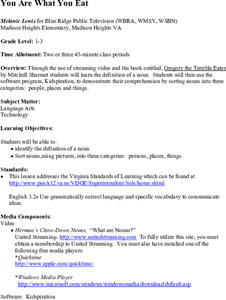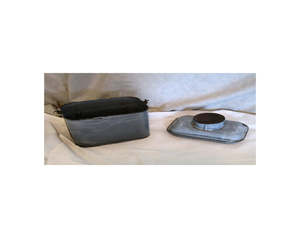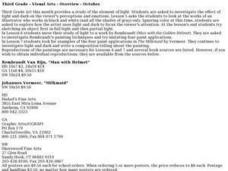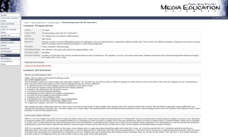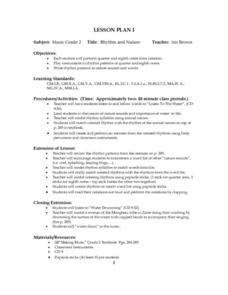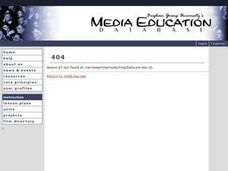Curated OER
It's a Matter of Opinion
Dissect the parts of an advertisement with your class. Middle schoolers discuss advertisements and locate the hook in them. Then, they create an advertisement for a business, in which they include the name of the business, an...
Curated OER
Writing the Essay
Relate the structure of the essay to the structure of a building. The class compares an essay to a building, with the writer being the architect, the introduction being the foundation, and so on. They use the visual representation of a...
Curated OER
Tapestry in the Middle Ages
Students study the use of tapestry in the daily lives of those living during the Middle Ages. They design and create a weaving of their own detailing artists' use of visual language and symbols throughout history. They write a story that...
Curated OER
Creating Children's Books
Students collaborate to create a children's book. In this visual arts activity, student study the components and procedures that go into making a children's book including the shape, size. layout, biographical information about the...
Curated OER
My Planet Earth
The earth is a delicate and fragile thing; Why not engage your class in a craft project that will make them aware of our environment? Earth Day is celebrated as recycled materials are used to create earth window hangings. Crayons are...
Film Education
The Jungle Book
Accompany a viewing of Disney's live-action feature film, The Jungle Book, with a packet equipped with several activities focused on story elements. Scholars discuss and complete diagrams and charts about the movie's characters, setting,...
Curated OER
Springfield Digital Storytelling Project #6: Grapes Commercial
Here is a fabulous instructional activity that should have your class very excited! They utilize the GRAPES formula in order to produce a commercial like ones we see on TV. Working in pairs, they must come up with a script, take video,...
Curated OER
You Are What You Eat
Youngsters listen to the story of Gregory the Terrible Eater and write a similar story using the same pattern. In the new book, Herman is requested to eat things that are nouns. They must supply the correct part of speech for the class...
Hawaiʻi State Department of Education
Dance Critic
What do writing and dance have in common? They both have a six-trait rubric for assessment. Just like a good story, a good dance must have a hook, beginning, middle, end, logical sequence, and a climax. Learners use a...
Curated OER
Lunch Pail
Explore a 1900s lunch pail. For this oral language and 1900s history lesson, students view a photograph of an old-fashioned lunch pail. Students describe the object and make predictions about what it is and its possible uses. Students...
Brigham Young University
Introducing the Text and Learning the Process of Script Analysis
Where do directors and set designers get their ideas so that the set they build creates the mood and atmosphere the director wants for a production? From the script! Introduce theater high schoolers to the script analysis techniques used...
Curated OER
The Southeast Region
Students write a song about the southeast region. In this southeast region lesson plan, students view pictures of landforms, hear music, look at maps of states, and more.
Curated OER
Light in Art
Third graders investigate the effect of light and dark on the art viewer's perceptions and emotions. They consider black and white illustrations along with paintings by Rembrandt and Vermeer. They conduct experiments with light and write...
Creative Visions Foundation
Developing a Structure for Documentaries
Provide some group brainstorming and story-planning time with the fifth lesson in a series on examining and creating documentaries. After you've explained the purpose of each section of a documentary, groups meet to plan the beginning,...
Curated OER
Math and the Greek-Golden Proportions
Fourth graders study math and the golden mean. For this math meets Greek history lesson, 4th graders study ratios and proportions in relation to the Greeks. The use of clay is incorporated ino this lesson.
Curated OER
Phenomenology Lesson Plan #6: Theme Part 1
Pupils practice differentiating between categories of art and entertainment. They also practice telling the difference between character themes and universal themes. They find a text to relate to themselves and write about it.
Curated OER
Rhythm and Nature
Second graders listen to song "Listen to the Water," discuss nature sounds and importance of water to life, perform quarter and eighth notes from notation, play instruments in rhythm patterns of quarter and eighth notes, and write rhythm...
Curated OER
The Arts of Sub Saharan Africa
Students research Sub-Saharan African art and the regions it comes from. In this African art lesson plan, students discuss art and compare the tribal and ceremonial art and what it is used for.
Curated OER
Ladybug Leaf
Learners employ a literary hook to promote number and color mastery through a hands-on craft experience. They participate in a mini-lesson on ladybugs. Students encounter what they are, what they look like and what do they eat.
Curated OER
Everyday Objects As Artwork
Students examine everyday Chinese objects and analyze why they are
considered artwork today in this multi-subject lesson for Middle School. Small group colaboration is emphasized.
Curated OER
Phenomenology Lesson Plan #3: Content Part 2
Learners examine magazine advertisements to identify how the product is being sold to the consumer. They work together in groups to respond to ads and explain why they are successful.
Curated OER
Phenomenology Lesson Plan #7: Theme Part 2
Students summarize the Phenomenology unit in this lesson. They identify character and universal themes from different films. They create a ten question survey for reviewer responses.
Curated OER
Phenomenology Lesson Plan #4: Character Part 1
Young scholars examine the way they react to characters and text. They write respones to different media tests. They are required to bring in a photograph and create a mini-biography for homework.
Curated OER
Water Cycle Lesson Plan
After conducting experiments with a sponge, ice water, and a soda bottle your young scientists become familiar with the water cycle through experiment, song, hand motions and drawing. Students sing about the water cycle and discuss...







